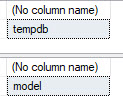DB_NAME() vs ORIGINAL_DB_NAME()
1March 15, 2018 by Kenneth Fisher
I’d never seen ORIGINAL_DB_NAME until recently and I thought it would be interesting to highlight it out, and in particular the difference between it and DB_NAME. I use DB_NAME and DB_ID fairly frequently in support queries (for example what database context is a query running from or what database are given DB files from). So starting with DB_NAME.
DB_NAME
Simply enough, if you pass a database_id in, it returns the databases name, if you don’t it returns the current databases name.
USE tempdb; SELECT DB_NAME(); SELECT DB_NAME(3);
ORIGINAL_DB_NAME
You might think this is always the database the connection initially connected to but you would be wrong. In fact, it returns a blank unless you specify a database to connect to in your connection string or connection options, etc. USE has no effect on the output and neither does your default database. There is also no parameter so this is the only value it will show. Using SQLCMD to make this a bit easier to see:
Without specifying -d (connect to a specific database)

VS
Honestly, the only possible use I can see for ORIGINAL_DB_NAME is for some forms of logging/auditing. Good information to know, but I’ll still be using DB_NAME 99% of the time.








[…] Kenneth Fisher explains a couple of database name functions in SQL Server: […]